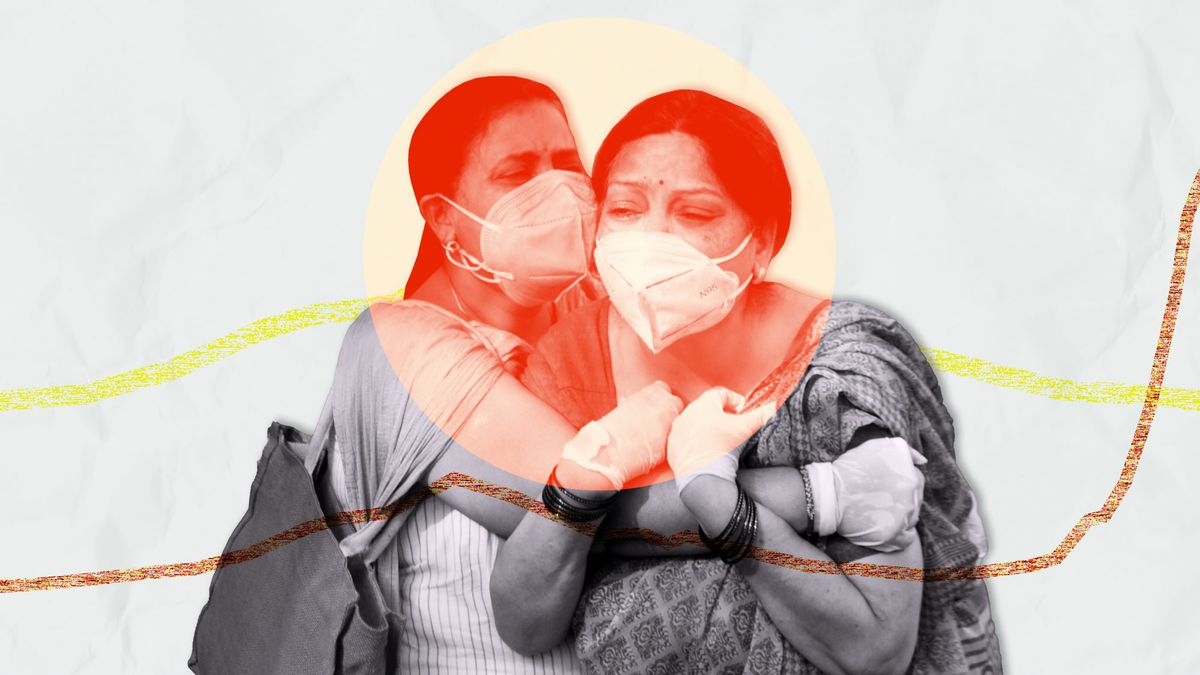

India's daily COVID-19 cases passed 400,000 for the second day in a row on Saturday, as the country continues to deal with a devastating COVID-19 surge. Prior to these record-high numbers, the country saw more than 300,000 daily cases a day for 10 days in a row, according to Reuters.
The massive and catastrophic surge in cases has overwhelmed hospitals and caused a scarcity of supplemental oxygen, a necessary tool for treating people with severe cases of COVID-19. Thousands are dying, according to CNN, and health officials are feeling "anguish" over the situation, according to a government press release issued on Sunday. World Health Organization Director-General Tedros Adhanom Ghebreyesus, PhD, called the situation "beyond heartbreaking" in a media briefing last week.
How did this happen? It's complicated. "What's occurring in India is multi-factorial in nature," infectious disease expert Amesh A. Adalja, MD, senior scholar at the Johns Hopkins Center for Health Security, tells Health. "Because India fared better than expected early on, it created a general sense of complacency."
This, he says, is coupled with the fact that early lockdowns in the country "were not sustainable for many of the individuals who lived in poverty." Those people then migrated out of cities and, when lockdowns were lifted, many people thought that the pandemic threat was over, Dr. Adalja explains.
The country's leadership also encouraged people to celebrate religious holidays and attend political rallies while the pandemic continued, Richard Marlink, MD, director of Rutgers Global Health Institute, tells Health. "They were having mass political rallies and sporting events promoted by the central government without masks or social distancing. That all contributed to the problem," Dr. Marlink says.
People then "began to carry on with their lives," Dr. Adalja says, adding, "this was all occurring at a time when the vaccine was not in high demand by the Indian population."
A more contagious COVID-19 variant also emerged in the country, where many people are not vaccinated, and that led "to an explosive growth of cases," Dr. Adalja says.
"It will not be easy to slow such a pace of infection down," he says. "Their priority has to be restoring hospital capacity coupled with aggressive vaccination."
At the same time, India's health care system caters more toward the country's wealthy while "neglecting severely the majority of the country that depends on public health systems and public hospitals," Dr. Marlink says.
Vaccine supplies are now limited in India, and many activists are pointing out that wealthier countries are on track to vaccinate any citizen who wants it while poorer countries are struggling to vaccinate even the most vulnerable. At the same time, pharmaceutical companies that make the vaccines are not sharing their formulas to speed up vaccination around the world.
The Biden administration announced last week that it will share the country's stockpile of AstraZeneca vaccines with other countries. "Given the strong portfolio of vaccines that the US already has and that have been authorized by the FDA, and given that the AstraZeneca vaccine is not authorized for use in the US, we do not need to use the AstraZeneca vaccine here during the next several months," White House COVID-19 coordinator Jeff Zients said in a press conference, per the Associated Press. "Therefore the US is looking at options to share the AstraZeneca doses with other countries as they become available." It's unclear if some of those doses will go to India.
What is clear, though, is that India is in crisis. Public health experts say that the COVID-19 case counts are underestimated, meaning the problem is likely much bigger than it already seems.
It's easy to feel powerless in a situation like this, but there are ways you can help. You can start by doing your own research into which organizations make you feel most comfortable donating to. The New York Times recently referenced both Guidestar and Charity Navigator, two websites that grade nonprofits for their effectiveness and financial health. You can also start with large international organizations, like the United Nations agencies (UNICEF and the World Health Organization) or narrow your choices down to organizations specifically in India, where your donations have a better chance of having a more direct impact, Dr. Marklink says.
If you're feeling overwhelmed with your possibilities, here are a few organizations that are taking donations:
- American Association of Physicians of Indian Origin, a U.S.-based nonprofit of more than 60,000 doctors is accepting donations to help provide oxygen concentrators to India.
- Americares is supporting more than 100 healthcare facilities in India over 14 states by providing essential equipment and supplies like ventilators, oxygen concentrators and pulse oximeters, PPE for frontline workers and telehealth consultation and medicine delivery.
- Care India is asking people to contribute to its emergency fund, which provides essential hospital services, more health workers, additional beds and oxygen supply to India.
- Indian Red Cross Society is issuing aid, distributing medical supplies, and providing essential services across the country.
- Ketto, an Indian crowdfunding site, is raising money to help buy oxygen concentrators for medical centers in India.
- UNICEF is delivering critical oxygen concentrators and diagnostic testing systems, hygiene supplies, and PPE kits to protect health care workers.
- Youth Feed India and Helping Hands Charitable Trust is sending ration kits that contain enough rice and dal to feed a family of four for 15 days to Mumbai's most vulnerable populations.
Source: Read Full Article